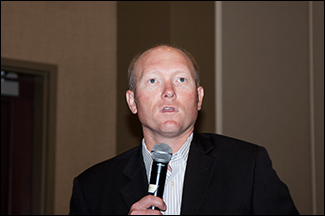Do We Need New Formula for YG?
Economist looks at USDA's beef yield-grading system, its history, current status and future.
by Troy Smith, field editor
MANHATTAN, Kan. (June 15, 2016) — The beef carcass yield-grading system used in the United States may not be completely broken, but it surely doesn’t work very well. That was the opinion that West Texas A&M University animal scientist Ty Lawrence offered during the 2016 Beef Improvement Federation Annual Meeting and Symposium hosted June 14-17 in Manhattan, Kan. Speaking before the Advancements in End Product Improvement breakout session, Lawrence called USDA’s method for determining beef yield grades “an antiquated system based on antiquated cattle.”

Ty Lawrence contends that instrument grading is superior to the more subjective determination of yield grade by humans. The bigger issue, however, is that cattle have changed over the decades, but the basis for calculating yield grade has not.
Sharing the history of its development and adoption, Lawrence said the yield-grading system is rooted in the 1950s. He explained how it was derived from data collected from just 162 beef carcasses representative of the period. Those data were used to develop a multiple-linear prediction equation using 12th-rib fat depth; percentage kidney, pelvic and heart fat (KPH); hot carcass weight; and ribeye area to estimate percentage of boneless closely trimmed round, loin, rib and chuck. Originally, there were 10 carcass rankings based on calculations using the original equation.
“A second equation was developed to estimate the previous equation — an estimate of an estimate,” said Lawrence, explaining how the calculated yield grade, with a 1 through 5 index, was adopted in 1965.
At inception, the yield grade(YG) was either determined from objective measures of 12th-rib fat depth and ribeye area or subjectively assessed. Development of an instrument-grading system began in 1980, leading to the introduction of grading by video image analysis in 2007. According to Lawrence, about 29% of beef carcasses currently are graded by humans; the majority are graded by cameras.
Lawrence contends that instrument grading is superior to the more subjective determination of yield grade by humans. The bigger issue, however, is that cattle have changed over the decades, but the basis for calculating yield grade has not.
“The era in which the yield grade was developed was dominated by small-framed, early-maturing cattle. In contrast, the current fed-beef population is a kaleidoscope of genetic diversity that is medium and large in frame,” stated Lawrence.
Additionally, cattle-feeding technology now includes growth promoting implants and beta-agonists that provide more opportunity to maximize growth and manipulate composition of gain. Genetics, technology and management have resulted in annual increases in hot carcass weight of 5 pounds (lb.), for steers, and 6 lb. for heifers. The current trend suggests that mean hot carcass weights will reach 1,000 lb. in the years 2040 and 2046 for fed steers and heifers, respectively. That’s far different than the 350- to 900-lb. range and the 600-lb. average hot-carcass weight that were representative of the cattle population from which the yield grade equation was derived.
“The purpose of yield grading is to predict the range of red meat yield, and the system currently predicts about 40% of the variation in red meat yield for beef-type cattle. In general, that’s not too bad,” said Lawrence. “But in Holsteins, yield grade predicts 0% of the variation. Yield grade is built on the measure of fat thickness, and there is not much variation of that in Holsteins.”
While he is critical of the yield-grading system, Lawrence believes it is better than the systems employed in Canada, Japan and Europe. Admitting that the U.S. system is “still the best one out there,” Lawrence called it sorely in need of improvement. However, USDA officials are reluctant to change, citing insufficient cause and fear of market disruption.
“We continue to use a yield estimation system developed from a small population of cattle that no longer exist to predict red meat yield of cuts that are increasingly leaner. We apply that estimate to carcasses that weigh beyond the inference of which it was designed, and we have ignored the opportunity to develop new yield estimates afforded by camera grading,” said Lawrence. “Leadership within the beef community must decide if the status quo is acceptable, or if improvement is warranted.”
Editor’s Note: This article is part of Angus Media’s coverage of the 2016 BIF Symposium and Annual Meeting. For full coverage of the event, visit the Newsroom and Award pages at http://www.bifconference.com. Angus Media’s coverage of the event is made possible through collaboration with BIF and sponsorship of LiveAuctions.tv.


